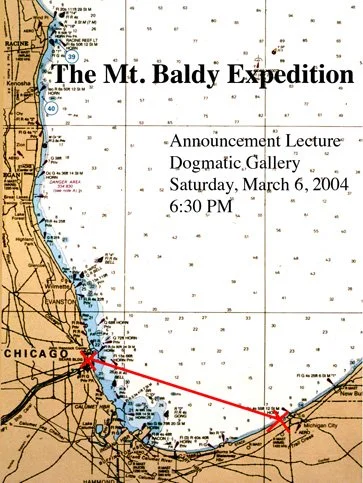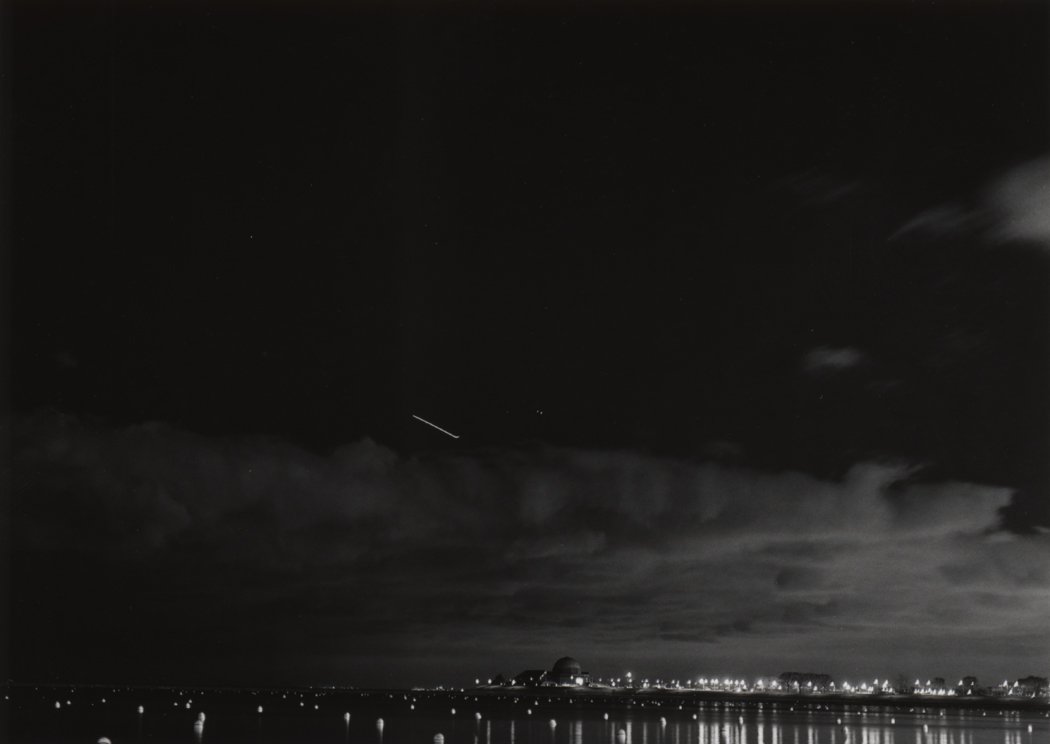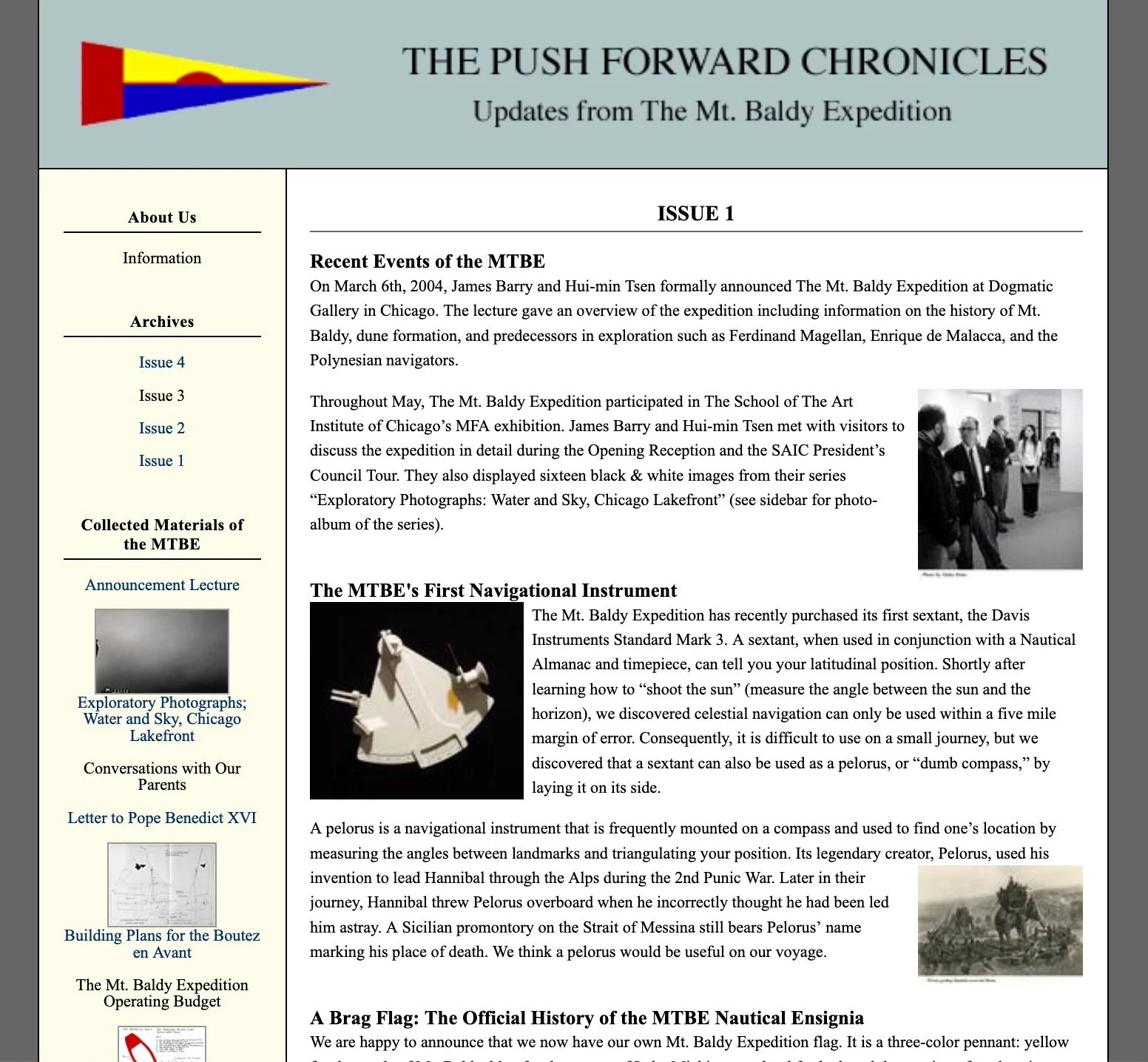The Mt baldy expedition announcement lecture
Date: 2004 | Performative Slide Lecture (25 minutes) | Dogmatic Gallery
On March 6, 2004, we formally announced our voyage of discovery, The Mt. Baldy Expedition, at Dogmatic Gallery in Chicago, IL. The following document is a transcript of the slide lecture we delivered on that evening with an introduction by Michael Thomas, the owner and operator of Dogmatic Gallery.
Introduction
Michael Thomas: Good-evening ladies and gentlemen, I am pleased to be introducing tonight's speakers to you on this, an occasion of more than ordinary interest.
[PAUSE]
"The oldest, most widespread stories in the world are adventure stories, about human heroes who venture into the myth-countries at the risk of their lives, and bring back tales of the world beyond men … It could be argued … that the narrative art itself arose from the need to tell an adventure, that [an individual] risking [his or her] life in perilous encounters constitutes the original definition of what is worth talking about (Zweig, vii, 6)."
Paul Zweig wrote that to introduce his book of literary criticism, The Adventurer, and I could not help but think that it would be appropriate to introduce tonight's speakers, President of the Mt. Baldy Expedition, James Barry, and Captain of the Boutez en Avant, Hui-min Tsen.
Mr. Barry and Captain Tsen are 21st century explorers. Their qualifications are beyond reproach for this project. They have traveled over four continents and have a familiarity with countless cities and rural environments. Captain Tsen began commanding boats in New England waters nearly twenty years ago, successfully competing against such formidable sailing organizations as MIT and Harvard. She is also an experienced surveyor and cartographer of urban and rural geographies. Mr. Barry is an accomplished wood worker and former student of Jay Smith, the Pacific Northwest's shipwright of traditional Nordic boats. For nearly eight years, he has conducted social experiments in the upper Midwest and singularly organized exhibitions of his findings. Additionally, he has participated in exhibiting archaeological research of Egypt, Persia, and Mesopotamia in various Chicago museums.
It is my great pleasure to introduce them tonight for their official announcement of the Mt. Baldy Expedition. Mr. Barry and Captain Tsen.
Hui-min Tsen: Thank-you, Michael for that introduction and for hosting this event. Your generosity is a testament to the inclusiveness of your gallery. I would also like to thank the artists currently on display, and of course, I would like to thank you all for joining us.
James Barry: Approximately eight years ago, I began reading about exploration. I read of the far off lands of Cathay that Marco Polo visited, the hardships that Ernest Shakleton endured, the perseverance of Ibn Battuta, the power of Zheng He's armadas, and the discoveries of Cook, LaSalle, and Nansen.
Tsen: For the past six years or so, I've been drawing on stories of explorers for inspiration. I was fascinated by Elisha Kent Kane's creation of the Open Polar Sea, Cabeza de Vaca's navigation of the unknown, the hero-worship of Scott, and the skill of the Polynesian navigators.
Barry: Less than a year ago, Ms. Tsen and I met. At that time, we had both been making artwork in the area of exploration; mine lay in the area of sociology and hers in urban cartography. Through conversations of our work, we discovered our shared interest in the history of exploration and realized that we had both fallen in love with the wonder, romance and adventure of these stories.
Tsen: Most of all, we talked of the voyage of Ferdinand Magellan and Enrique de Malacca, the first circumnavigators of the world. They ventured out into the unknown and through perseverance overcame unforeseen hardships and with luck achieved their goal.
Barry: Ferdinand Magellan and Enrique de Malacca met in the Spice Islands. Magellan was there establishing trade for Portugal. In a battle on Malacca, he took Enrique captive. Enrique was his slave.
Tsen: It is there that their circumnavigation of the world begins. When Magellan brought Enrique back with him to Europe, they completed a third of their journey around the world.
Barry: Something to keep in mind is that spice at this time was one of the most highly prized commodities. A sailor returning with a bag full of spices could live comfortably for the rest of his life. The two main powers in the spice trade were Spain and Portugal. The pope had divided the world between these nations. But the problem was no one had an accurate way of judging longitude, and they had no idea what was on the other side of the world. Portugal owned the route east around the Cape of Good Hope and all that lay east of there, and Spain owned most of the New World and all that lay west of there. Since the division on the far side of the world was not specified, Spain felt it had a claim to anywhere reached by a western route. It was for this reason that the king of Spain sent Magellan west.
Tsen: For Magellan, who had wanted to be an explorer ever since Columbus' discovery of the new world, such an expedition would mean fame and glory and a rise in status. The journey had problems from the start, but the real problem was the uncertainty involved. Nobody knew where, exactly, they were going or what they would find. The crew was scared and thought that Magellan was leading them all to destruction. When the armadad passed off the charts of the known world, somewhere along the Brazilian coast,they mutinied. After subduing the mutiny, Magellan had one of the mutinous captains beheaded by his own servant, then drawn, quartered and displayed as an example. Two other instigators were marooned.
[PAUSE]
Barry: Magellan proceeded down the coast searching every inlet, for a passage to the other side of the continent. He would taste the water to test its salinity, but over and over again, it turned to fresh water, a definite sign that no passage existed.
Tsen: It was beginning to look like they would never find the straights. The crew wanted to take the known eastern route around Cape of Good Hope to the Indian Ocean, but this would weaken the Spanish claim to the Spice Islands and mean failure for Magellan.
Barry: One day the ships got caught in a huge storm. Two ships were driven towards the coast and disappeared into the surf. The two remaining ships were driven out to sea where they fought the storm for several days. When the sky cleared, the ships were severely damaged, and men had been lost overboard. Without the provisions contained in the two lost ships, it looked like they would have to turn back for Spain. Just as the Armada was going to give up, the lookout spotted two ships on the horizon. Instead of being shipwrecked, luck had driven them right into the straights and to the Pacific.
Tsen: Magellan and his crew became the first Europeans to sail the Pacific Ocean, but unfortunately, a trip they thought would take 3 or 4 days stretched into 3 1/2 months. Amazingly, they sailed between dozens of South Pacific islands missing every single one. On their arrival in the Philippines, though, they became the first circumnavigators of the world.
[BIG PAUSE]
Barry: We have become so caught up in reading stories such as this that we deem it reasonable and necessary, both for our own sake and as a service to our society, to become explorers and engage in everything we have read explorers engage in. For that reason, we are setting out on a voyage of discovery we have titled The Mt. Baldy Expedition in which we will build a sailboat, sail across Lake Michigan using personally developed navigation methods to Mt. Baldy where we will document its movement and collect other pertinent data.
[PAUSE]
Tsen: Our projected schedule for the expedition is as follows. Due to the harsh Chicago winter and lack of funding for an interior building site, building of the boat begins this month and will continue through the spring. During this time, we will continue our research and begin a physical training program at our local natatoriums. On May 12th, we will christen the boat the Boutez en Avant and start extensive tests of our equipment. In early July, we will have a restricted donor's tour of the Boutez en Avant, and on July 18th, we launch the expedition. Upon our return to Chicago, we will commence on a lecture tour to share our findings with the Chicago community.
Barry: The expeditionary vessel, the Boutez en Avant is a San Francisco Pelican. It was designed in 1959 by Captain William Short, a steam tugboat commander and 35 year veteran of the merchant service on the waters of San Francisco Bay. Captain Short began his life at sea during World War II in the India Burma Campaign where he frequently sailed Sampans, dhows, and other native craft. After returning from the war, he used these experiences as inspiration to create a heavy weather sailing dinghy for his children to learn to sail in the choppy waters and gusty winds of the San Francisco Bay. The Pelican is an extremely stable and safe dinghy. It is completely decked over, has protective cockpit combings and more than generous freeboard. Additionally, it is inexpensive and easy to build. Constructed of plywood, it has a length overall of 12' 2 1/2", a beam of 6' 1 3/4", a draft with the centerboard up of 4", a draft with the centerboard down of 4', and flies a total of 105 sq. feet of sail.
Tsen: Careful planning has been essential for a venture of this sort. We have meticulously examined weather and wave patterns of southern Lake Michigan and feel the middle of July has the optimal sailing conditions for the Pelican. Regardless of preparations, Lake Michigan has very unpredictable weather conditions. There can be wind gusts of up to 55 knots and prevailing winds from the north can create waves that reach over thirty-six feet in height. That's over three times as high as our dinghy is long.
Barry: If traveled in a straight path, Mt. Baldy is nearly 2/3 of a longitudinal minute from Chicago. That is a path of approximately 35 nautical miles across open water at a distance of up to 12 miles from shore. Once the largest live sand mountain in the world, Mt. Baldy is now a sand dune in the Indiana Dunes National Lakeshore. It has long been a destination for day trips and other diversions. Yet over time, its usefulness to society has diminished its size. Primarily used as fill material, Mt. Baldy provided the foundation of Jackson Park here in Chicago for the 1893 World Exposition. Also, great quantities of its sand have been used to create man-made beaches and golf course sand traps.
Tsen: Although depleted over the last century, Mt. Baldy continues to grow. A dune can start with a pebble and through a process called saltation grow into a mountain. Saltation, in geological terms, is "the leaping movement of sand as it is transported in a fluid medium over an uneven surface." This process has been occurring at Mt. Baldy since the Laurentide Ice Sheet ended its advance nearly 10,000 years ago and created Lake Michigan as it retreated. In addition to forming it, saltation enables Mt. Baldy to move. Currently, the mountain advances into the state of Indiana at a rate of 5 to 6 feet a year.
Barry: During our voyage to Mt. Baldy, we will rely on a self-developed navigation system inspired by the great Polynesian navigators who determined their location by observing ocean swells, bird migrations, and the stars. This chart from the Marshall Islands is an example of how they would show the relationship between wave and wind patterns and the land.
Tsen: We will navigate by using the flight paths of planes to and from O'Hare and Midway airports, the light spots created in the sky by cities such as East Chicago, Gary and Michigan city, and the shipping lanes on Lake Michigan, which we must avoid. We will be creating a chart to document this process and our journey.
[PAUSE]
Barry: When we arrive at Mt. Baldy we will explore its surface and surrounding areas. We will track its movement and represent it cartographically using Ptolemy's view of the world as a model.
[PAUSE]
Tsen: This project requires a multitude of equipment. There are boatbuilding supplies of marine plywood, spruce for the spares, and oak for the thwarts and knees, nautical supplies such as sails, blocks, and line. Then there are scientific instruments and safety equipment as well as documentation, publicity, and exhibition expenses.
Barry: For this expedition to achieve success, we need support from multiple sources. The more resources we have the greater our ability to reach our destination and convey our results to the public. Therefore, we are inviting you to participate in this expedition, as Michael Thomas and Dogmatic Gallery already have and make a donation to the Mt. Baldy Expedition. Please take an active roll in our present and push forward the future of exploration.



